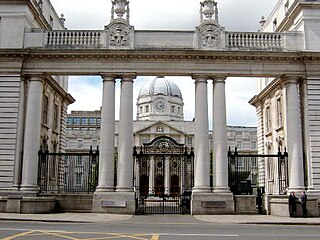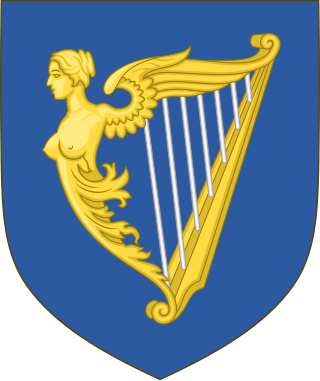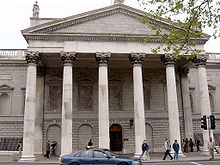History
The Lords started as a group of barons in the Lordship of Ireland that was generally limited to the Pale, a variable area around Dublin where English law was in effect, but did extend to the rest of Ireland. They sat as a group, not as a separate House, from the first meeting of the Parliament of Ireland in 1297. From the establishment of the Kingdom of Ireland in 1542 the Lords included a large number of new Gaelic and Norman lords under the policy of surrender and regrant.
Religious division was reflected in the House, but as late as the 1689 "Patriot Parliament" a majority of Lords had remained Roman Catholics, while the administration and a slight majority in the Commons were Anglicans, adherents of the Church of Ireland. In 1634 the campaign to secure "The Graces" came to a head. Most of these Catholic lords lost their titles in the ensuing 1641 rebellion, notably during the 1652 Cromwellian Settlement. These dispossessed lords were regranted their titles (if not always their lands) after the Restoration of 1660 by the Act of Settlement 1662. Others took the losing side in the Williamite War in Ireland (1689–91), and a much smaller number of them were re-granted their lands in the 18th century.
By the 1790s most of the Lords personified and wanted to protect the "Protestant Ascendancy". By the time of the abolition of the Irish House of Lords in 1800 some of the peerages were very ancient, such as the lords Kingsale, created in 1397, and the viscounts Gormanston from 1478. The first Earl of Kildare had been created in 1316.
Following the Act of Union in 1800, the peerage of Ireland elected just 28 of their number to sit in the United Kingdom House of Lords, described as the "Irish representative peers". This practice ended in 1922 with the establishment of the Irish Free State. Other newly created Irish peers, such as Clive of India, the Earl of Carysfort and Lord Curzon, were still able to stand for election to the House of Commons of the United Kingdom (not being UK peers) if they were not a representative peer. This was a convenient way of giving a title for reasons of prestige to someone who expected to sit in the British House of Commons. [3]
Today the 18th-century Irish Parliament building on College Green in Dublin is an office of the commercial Bank of Ireland, and visitors can view the Irish House of Lords chamber within the building.
Function
The Parliament of Ireland was a bicameral legislature, and bills could originate in either the Commons or the Lords; both had to pass a bill for it to stand a chance of becoming law. Either house could amend or reject the others' proposals. Under Poynings' Law, matters passed by the Irish parliament had to be approved and could be amended by the Irish Privy Council and English Privy Council; main debates before this stage were thus technically on "heads of bills". Following approval the Parliament of Ireland voted on the formal finalised "bill" (which could only be rejected or passed unamended).
The Lords was the highest court of appeal in Ireland, same as the Lords were in England. However, the controversial British Declaratory Act 1719 asserted the right of the Lords in Westminster to overrule the Irish Lords. The Irish Patriot Party secured the repeal of the Declaratory Act as part of the Constitution of 1782.
The House of Lords was presided over by the Lord Chancellor, who sat on the woolsack, a large seat stuffed with wool from each of the three lands of England, Ireland and Scotland. At the state opening of the Irish parliament Members of Parliament were summoned to the House of Lords from the House of Commons chamber by Black Rod, a royal official who would "command the members on behalf of His Excellency to attend him in the chamber of peers". Sessions were formally opened by the Speech from the Throne by the Lord Lieutenant, who sat on the throne beneath a canopy of crimson velvet.
Sessions were generally held at Dublin Castle in the 16th and 17th centuries, until the opening of the Irish Houses of Parliament in the 1730s.

The House of Lords is the upper house of the Parliament of the United Kingdom. Like the lower house, the House of Commons, it meets in the Palace of Westminster in London, England. One of the oldest institutions in the world, its origins lie in the early 11th century and the emergence of bicameralism in the 13th century.

The Parliament of the United Kingdom of Great Britain and Northern Ireland is the supreme legislative body of the United Kingdom, and may also legislate for the Crown Dependencies and the British Overseas Territories. It meets at the Palace of Westminster in London. Parliament possesses legislative supremacy and thereby holds ultimate power over all other political bodies in the United Kingdom and the Overseas Territories. While Parliament is bicameral, it has three parts: the sovereign, the House of Lords, and the House of Commons. The three parts acting together to legislate may be described as the King-in-Parliament. The Crown normally acts on the advice of the prime minister, and the powers of the House of Lords are limited to only delaying legislation; thus power is de facto vested in the House of Commons.

Whilst the House of Lords of the United Kingdom is the upper chamber of Parliament and has government ministers, for many centuries it had a judicial function. It functioned as a court of first instance for the trials of peers and for impeachments, and as a court of last resort in the United Kingdom and prior, the Kingdom of Great Britain and the Kingdom of England.

Lord Lieutenant of Ireland, or more formally Lieutenant General and General Governor of Ireland, was the title of the chief governor of Ireland from the Williamite Wars of 1690 until the Partition of Ireland in 1922. This spanned the Kingdom of Ireland (1541–1800) and the United Kingdom of Great Britain and Ireland (1801–1922). The office, under its various names, was often more generally known as the Viceroy, and his wife was known as the vicereine. The government of Ireland in practice was usually in the hands of the Lord Deputy up to the 17th century, and later of the Chief Secretary for Ireland.
The Peerage of Ireland consists of those titles of nobility created by the English monarchs in their capacity as Lord or King of Ireland, or later by monarchs of the United Kingdom of Great Britain and Ireland. It is one of the five divisions of Peerages in the United Kingdom. The creation of such titles came to an end in the 19th century. The ranks of the Irish peerage are duke, marquess, earl, viscount and baron. As of 2016, there were 135 titles in the Peerage of Ireland extant: two dukedoms, ten marquessates, 43 earldoms, 28 viscountcies, and 52 baronies. However, these titles have no official recognition in the Republic of Ireland, with Article 40.2 of the Constitution of Ireland forbidding the state conferring titles of nobility and stating that an Irish citizen may not accept titles of nobility or honour except with the prior approval of the Irish government.

Parliament House in Dublin, Ireland, was home to the Parliament of Ireland, and since 1803 has housed the Bank of Ireland. It was the world's first purpose-built bicameral parliament house. It is located at College Green.

The Lord Chancellor, formally titled Lord High Chancellor of Great Britain, is the highest-ranking traditional minister among the Great Officers of State in Scotland and England in the United Kingdom, nominally outranking the prime minister. The lord chancellor is appointed by the sovereign on the advice of the prime minister. Prior to the union of England and Scotland into the Kingdom of Great Britain, there were separate lord chancellors for the Kingdom of England and the Kingdom of Scotland. There were Lord Chancellors of Ireland until 1922.

The Peerage Act 1963 is an Act of the Parliament of the United Kingdom that permits women peeresses and all Scottish hereditary peers to sit in the House of Lords and allows newly inherited hereditary peerages to be disclaimed.
The introduction is a ceremony in the House of Lords of the United Kingdom by which a new member is "introduced" to the existing membership. Introductions in the Lords are more elaborate than those in the House of Commons.
In the United Kingdom, representative peers were those peers elected by the members of the Peerage of Scotland and the Peerage of Ireland to sit in the British House of Lords. Until 1999, all members of the Peerage of England held the right to sit in the House of Lords; they did not elect a limited group of representatives. All peers who were created after 1707 as Peers of Great Britain and after 1801 as Peers of the United Kingdom held the same right to sit in the House of Lords.

The House of Lords Act 1999 is an Act of the Parliament of the United Kingdom that reformed the House of Lords, one of the chambers of Parliament. The Act was given Royal Assent on 11 November 1999. For centuries, the House of Lords had included several hundred members who inherited their seats ; the Act removed such a right. However, as part of a compromise, the Act did permit ninety-two hereditary peers to remain in the House. Another ten were created life peers to enable them to remain in the House.

Earl of Caledon, of Caledon in the County of Tyrone, is a title in the Peerage of Ireland. It was created in 1800 for James Alexander, 1st Viscount Caledon. He was a merchant who had made an enormous fortune in India. He also represented the constituency of Londonderry City in the Irish House of Commons. Alexander had already been created Baron Caledon in 1790 and Viscount Caledon, of Caledon in the County of Tyrone, in 1797, also in the Peerage of Ireland. In 1784, James Alexander purchased a city house in Dublin at Rutland Square where he lived when serving as an MP for Derry.

The Parliament of Southern Ireland was a Home Rule legislature established by the British Government during the Irish War of Independence under the Government of Ireland Act 1920. It was designed to legislate for Southern Ireland, a political entity which was created by the British Government to solve the issue of rising Irish nationalism and the issue of partitionism, while retaining the whole of Ireland as part of the United Kingdom.
The hereditary peers form part of the peerage in the United Kingdom. As of August 2023, there are 805 hereditary peers: 30 dukes, 34 marquesses, 189 earls, 110 viscounts, and 442 barons.
The history of the British peerage, a system of nobility found in the United Kingdom, stretches over the last thousand years. The current form of the British peerage has been a process of development. While the ranks of baron and earl predate the British peerage itself, the ranks of duke and marquess were introduced to England in the 14th century. The rank of viscount came later, in the mid-15th century. Peers were summoned to Parliament, forming the House of Lords.
The privilege of peerage is the body of special privileges belonging to members of the British peerage. It is distinct from parliamentary privilege, which applies only to those peers serving in the House of Lords and the members of the House of Commons, while Parliament is in session and forty days before and after a parliamentary session.

The Parliament of Ireland was the legislature of the Lordship of Ireland, and later the Kingdom of Ireland, from 1297 until the end of 1800. It was modelled on the Parliament of England and from 1537 comprised two chambers: the House of Commons and the House of Lords. The Lords were members of the Irish peerage and bishops. The Commons was directly elected, albeit on a very restricted franchise. Parliaments met at various places in Leinster and Munster, but latterly always in Dublin: in Christ Church Cathedral, Dublin Castle, Chichester House (1661–1727), the Blue Coat School (1729–31), and finally a purpose-built Parliament House on College Green.
Since 1997 the United Kingdom government has been engaged in reforming the House of Lords, the upper house of the Parliament of the United Kingdom. The history of reform before 1997, is set out in sections below about reforms of composition and powers carried out in the past and of unsuccessful proposals and attempts at reform in the twentieth century. Proposals include decreasing the number of lords, introducing a system where lords are democratically elected, or abolition of the House of Lords in favour of a unicameral Parliament.
Robert Dillon, 2nd Earl of RoscommonPC (Ire) was styled Baron Dillon of Kilkenny-West from 1622 to 1641 and succeeded his father only a year before his own death. He supported Strafford, Lord Deputy of Ireland, who appointed him keeper of the great seal. Dillon was in December 1640 for a short while a lord justice of Ireland together with Sir William Parsons.














